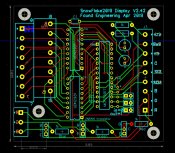queenidog
New elf
- Joined
- Dec 23, 2020
- Messages
- 3
Hi from Canada! We have snow here...our winter. Merry Christmas to all, be safe this Covid Christmas!
I like making light displays for Christmas and have been doing so since 1982 when I made my first computer controlled light display. It used a Motorola 6809 development kit, assembler programming, and 1 watt incandescent bulbs driven by triacs via 36 volt transformers. Wow! What a "kludge". But it worked and got me on TV news.
My latest (2020) is Arduino driven, using addressable I2C port expanders, 3W pixels, in a 7foot diameter Star and 8 foot diameter "snowflake" pattern. Power comes from ATX power supply running 12 volts for the LEDs and 5 volts for logic. MCU is Arduino UNO in both cases.
Video here:
View: https://youtu.be/tLRitDK7fv4
.
I'm currently making an 8 x 32 matrix for a sign using same technology, but want to try something new for 2021. Read on.
Here's my issue: I want a NeoPixel display/led strip that is HIGH POWER, ie 1w-3w pixels. I need this because my displays are across a cove, 700 feet to nearest road. I use 3w pixels now, but in actuality they only consume 1W max with my wiring setup (100 ohm resistors). I have standard neopixels visible from 20 feet...not good enough.
I bought some SOIC-8 WS2811 chips to start designing an interface using MOSFETS or bipolar transistors. I've used both, but never with a device (ws2811) that is constant current so I'm unsure how to interface and make it all work. Any ideas out there? I make my own PCBs, so not a problem, example photo for Star made last year.
I like making light displays for Christmas and have been doing so since 1982 when I made my first computer controlled light display. It used a Motorola 6809 development kit, assembler programming, and 1 watt incandescent bulbs driven by triacs via 36 volt transformers. Wow! What a "kludge". But it worked and got me on TV news.
My latest (2020) is Arduino driven, using addressable I2C port expanders, 3W pixels, in a 7foot diameter Star and 8 foot diameter "snowflake" pattern. Power comes from ATX power supply running 12 volts for the LEDs and 5 volts for logic. MCU is Arduino UNO in both cases.
Video here:
View: https://youtu.be/tLRitDK7fv4
.
I'm currently making an 8 x 32 matrix for a sign using same technology, but want to try something new for 2021. Read on.
Here's my issue: I want a NeoPixel display/led strip that is HIGH POWER, ie 1w-3w pixels. I need this because my displays are across a cove, 700 feet to nearest road. I use 3w pixels now, but in actuality they only consume 1W max with my wiring setup (100 ohm resistors). I have standard neopixels visible from 20 feet...not good enough.
I bought some SOIC-8 WS2811 chips to start designing an interface using MOSFETS or bipolar transistors. I've used both, but never with a device (ws2811) that is constant current so I'm unsure how to interface and make it all work. Any ideas out there? I make my own PCBs, so not a problem, example photo for Star made last year.


